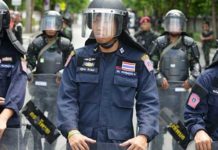The senseless death of a 15-year-old boy who drowned while attending a boy scout camp in Kalasin province early this week is another example of the tragic repetition of an avoidable mistake: lax safety precautions in outdoor school activities.
In the latest tragedy, it was reported that the ill-fated student who could not swim was forced by his teacher to jump and dive into a three-metre-deep pond at the back of the school in tambon Kud Doen in Huai Mek district to retrieve an object as part of a Spartan obstacle course.
The boy had pleaded that he could not swim, but the teacher did not believe him.
And, indeed, be couldn’t, as the water swallowed him up the moment he jumped in. His body resurfaced a few hours afterwards.
It remains unknown why teachers did not immediately come to his rescue or what rescue actions were taken, if any.
As of now, all his grieving parents can do is lodge complaints against all those teachers present or responsible for the activity as it appears undue care was taken over ensuring the safety of the student participants.
Sadly, this isn’t the first fatal mishap to have happened during a school activity, but it appears that lessons still haven’t been learnt.
At a science camp in Oct 2019, a nine-year-old female student drowned at a science camp held at a hotel in Phetchaburi’s Cha-am district.
It’s reported that the girl lost consciousness during a swimming session at the hotel’s pool. Her parents insisted that the girl could swim and was in robust health, although the school told the public that the girl died as a result of a chronic illness.
The main questions that parents and society need answers to are whether or not schools are fulfilling their duty to assess students’ health and capability for strenuous tasks beforehand and what safety measures are in place at the venues.
As it stands, it seems inevitable that it’s only a matter of time before another child dies unless the Ministry of Education shows some teeth and imposes an overarching safety protocol for all adults in charge of outdoor group activities involving minors.
It is both absurd and negligently dangers if students who can’t swim are being encouraged to take part in tasks where they are out of their depth in swimming pools or lakes.
According to the Department of Disease Control under the Public Health Ministry, 559 out of 3,306 — or about one-sixth — of those who drowned in 2019 were aged below 15 years old. In the first eight months of last year, 692 children of that age or younger died of the same cause.
In fact, the Office of the Basic Education Commission appeared in 2019 to have taken note of such grim statistics and proposed a policy that would see all children taught how to swim.
While the policy required all schools in Thailand to provide a swimming course, it lost momentum due to budget constraints and a lack of swimming pools in far-and-away areas.
It remains unknown whether Thai students will ever receive the swimming tuition that may save their lives one day.
But right now, what the Education Ministry can do to protect them is require schools to have adequate numbers of staff present and ensure that they are trained in safety procedures and rescue scenarios.
It would also be prudent to prohibit non-swimmers being allowed in the water. After all, these are our children and our schools, not military training camps. – Bangkok Post










































